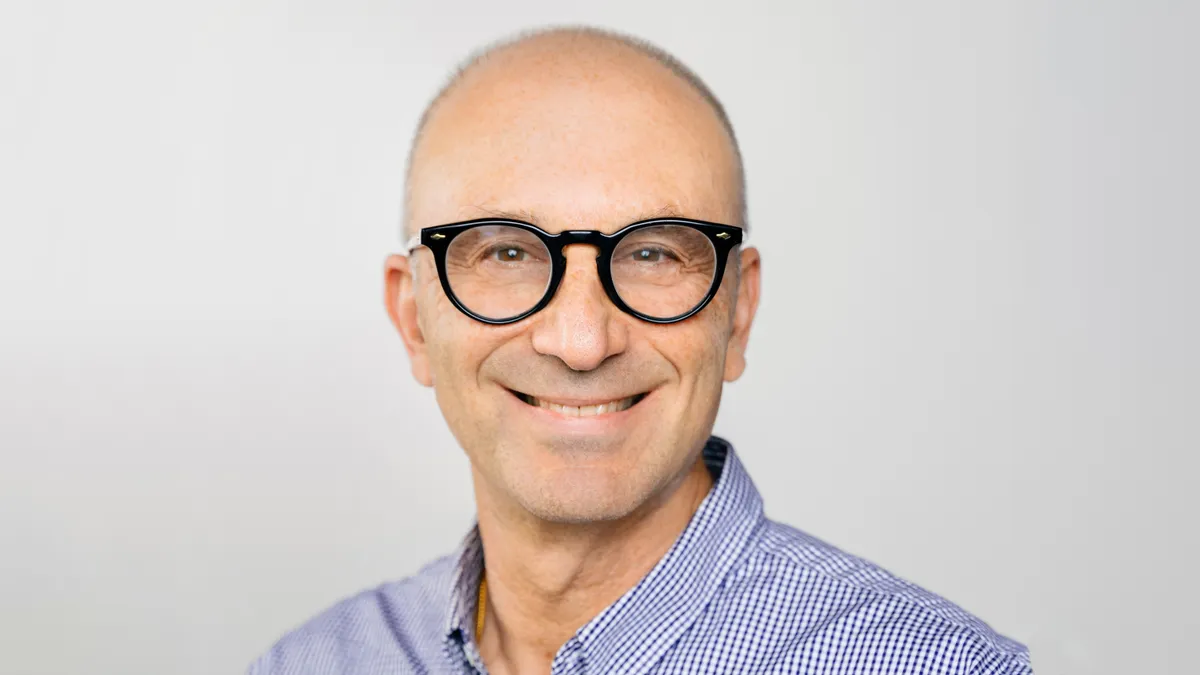What makes for a great leader? Many books and articles exist to try to tease out the qualities and behaviors that make good leaders great. Many of these detail that leaders inspire employees, position their companies for innovation and change, and they have integrity and the courage to lead.
A McKinsey survey in 2015 of 189,000 people in 81 diverse organizations found four specific behaviors in companies with high-quality leadership. These include: solving problems effectively, operating with a strong results orientation, seeking different perspectives, and supporting others. These four behaviors account for 89% of leadership effectiveness.
We spoke with several leaders in pharmaceutical R&D about the traits those in leadership positions need today and what skills will be important tomorrow. A few common themes emerged. All said 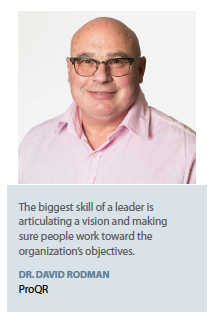 knowledge and the ability to keep up with scientific advances are critical. The increasing importance of biology, genetics, big data, and technology in therapeutic development has underscored many of the changes in R&D in the past decade.
knowledge and the ability to keep up with scientific advances are critical. The increasing importance of biology, genetics, big data, and technology in therapeutic development has underscored many of the changes in R&D in the past decade.
But even more important for today’s R&D leaders is the need for agility and the ability to collaborate internally and externally to achieve the goals of their organizations. Successful leaders must constantly have their eye on new opportunities and be willing to embrace change in order to work toward the newest breakthrough.
Many of the leaders we spoke with mentioned the need to inspire and motivate their teams to be productive and bring novel products to the market. R&D leaders need to build strong, diverse teams that are willing to explore cutting-edge trends, says Shao-Lee Lin, M.D., Ph.D., executive VP, head of research and development and chief scientific officer, Horizon Pharma.
“Successful R&D leaders must possess a vision, equally focused on technical aspects of innovation and developing a culture that will best support innovation," Dr. Lin says. “All transformational leadership begins with a vision. And all innovation begins with curiosity and passion, so an R&D leader must have a high degree of both to match the required technical skills."
Martin Huber, M.D., chief medical officer, Tesaro, agrees that leadership is about creating a compelling vision.
“Leadership is about determining a strategy for the business and where the company wants to go," he says. “But it’s not as simple as a strategy. There has to be a vision. There has to be a reason people want to do the work of R&D."
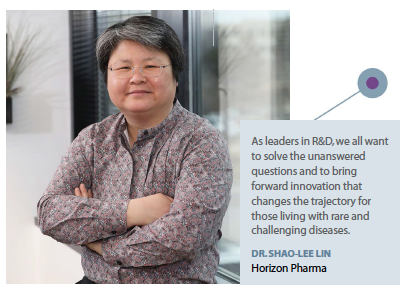 In pharmaceutical R&D, helping patients is a compelling vision, he says. “This vision can help each person in the organization and inspire each person to come to work as opposed to just showing up for a paycheck. It is the leadership of the organization that helps people understand that vision."
In pharmaceutical R&D, helping patients is a compelling vision, he says. “This vision can help each person in the organization and inspire each person to come to work as opposed to just showing up for a paycheck. It is the leadership of the organization that helps people understand that vision."
David Rodman, M.D., executive VP of research and development, ProQR, says in addition to being good at articulating a vision, good leaders listen to the people they’ve hired to do the job, and then stand back.
“Leaders should be problem solvers and make sure people stay on message, work toward the objectives that have been set, and make sure that everybody is set up for success," he says.
Rob Scott, M.D., chief medical officer and VP of development, AbbVie, says a leader inspires people to follow him or her.
“People want to follow a leader not because he or she is the most senior person in the organization, but because that person can help them advance the mission," he says. “It’s not enough just to be anointed by the organization as the most senior person and to have the power. Leaders have to be able to inspire trust and loyalty in the team; those skills are a lot more subtle than they used to be."
Suma Krishnan, founder and chief operating officer of Krystal Biotech, believes making sure people are excited about the work they are doing is one of her key roles.
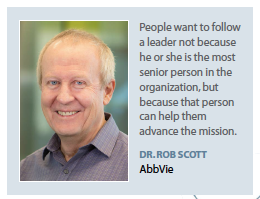 “As a leader I motivate and inspire my team to work," she says. “I try and show by example. I am there at the ground level with them at every aspect."
“As a leader I motivate and inspire my team to work," she says. “I try and show by example. I am there at the ground level with them at every aspect."
Building Teams for Success
R&D leaders surveyed by Deloitte in a 2017 Pharmaceutical R&D Leadership Survey are attempting to break down silos between functions by forming cross-functional groups. Initiatives cited in the survey include promoting the importance of sharing knowledge between departments.
R&D leaders we spoke with all agreed that central to leadership is creating and building teams for success.
“R&D leaders need to build strong, diverse teams that are willing to explore cutting-edge trends," Dr. Lin says. “Successful R&D leaders foster team dynamics that build upon the idea that all of us are able to achieve more than any one of us, and that by thinking in different ways we are able to see possibilities in different ways. Adaptable, multifaceted, and layered R&D teams often identify and respond to innovative solutions faster."
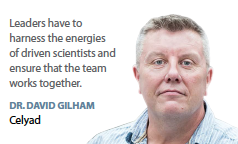 Leadership, Dr. Huber says, also is about helping people understand when an organization is going through challenges. One of those challenges, he says, is the rapidity at which things change, and the next generation of leaders will need to be able to lead when there is high volatility.
Leadership, Dr. Huber says, also is about helping people understand when an organization is going through challenges. One of those challenges, he says, is the rapidity at which things change, and the next generation of leaders will need to be able to lead when there is high volatility.
“It was much easier when we could create a fixed goal with a four- or five-year timeframe and build the vision around those goals," he says. “Change is hard for people, and it can take a lot of time and energy to get people to buy into any change. The leadership ability of helping people manage through the uncertainty of the external environment is critical."
David Gilham, Ph.D., VP of research and development, Celyad, says R&D leaders have to harness the energies and qualities of team members. “Leaders have to ensure that the team works together and that everyone understands what they’re doing and to make sure everyone’s goals are aligned."
Different people bring unique skill sets to the table, says Maria Fardis, Ph.D., president and CEO of Iovance. “Everybody who is successful in R&D has different skill sets," she says, adding that there’s no replacement for tenacity, hard work, and optimism.
“R&D team members have to be optimistic about basic sciences to be able to come to work every day in light of the fact that the failure rate is incredibly high in R&D organizations," she says. “Working in R&D requires true optimism, enthusiasm about the future of drug development, and a belief that what they do for patients is positive. Almost no other job has this degree of failure rate."
Dr. Fardis says optimism helps her go to work every day despite what might have happened the previous day. “Patients are waiting," she says. “There’s not a moment to lose. Encouraging the team and continuing the momentum is important in a smaller organization. Putting forward positivity, having an optimistic outlook, and getting our hands dirty goes a long way to help team spirit shine."
Knowledge and Collaboration
R&D leaders surveyed by Deloitte in a 2017 Pharmaceutical R&D leadership survey most frequently mentioned initiatives that were related to developing internal technical and data capabilities, with companies looking to harness growing volumes of data generated during clinical development. Other common initiatives were aimed at boosting operating efficiency. Game-changing moves are centered on big data exploitation, reducing time to launch, better predictors of new treatments, building technical capabilities, ensuring efficient governance and decision making, and putting forward novel clinical trial models.
Our leaders say over the last decade, R&D strategies have changed — and so must leaders.
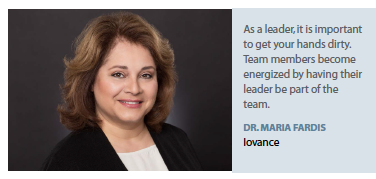 Advances in genetics, immune-oncology, molecular pathogenesis of disease, and novel targets mean companies’ R&D risks are now higher. Today’s R&D efforts encompass more than science; executives must be well versed in the art of innovation and maintaining a strong culture of collaboration within their R&D organizations, the company overall, and in the community.
Advances in genetics, immune-oncology, molecular pathogenesis of disease, and novel targets mean companies’ R&D risks are now higher. Today’s R&D efforts encompass more than science; executives must be well versed in the art of innovation and maintaining a strong culture of collaboration within their R&D organizations, the company overall, and in the community.
“Collaboration paves the way to accomplish shared goals, and for R&D leaders it means bringing in broad perspectives internally and externally," Dr. Lin says. “With partnerships continuing to take on new forms, R&D executives must ensure efficiency as they structure teams and approaches to maximize potential opportunities, while maintaining a clear focus on development objectives. These challenges are more than process changes that many R&D executives must work through. It starts with cultivating the culture and mindset to look inside and outside of traditional approaches to bring forth sustainable and scalable innovation."
In this environment, leaders need to be adaptable and opportunistic, Dr. Rodman says. “When I joined the industry in 2005, the paradigm was to develop a de-risked program that had already been shown as target validated," he says. “Now, the strategy is to find a new target and make the best drug for that target. This approach might lead to another Kalydeco, which is the only drug in the class to treat cystic fibrosis. Or, it might lead to PCSK9 for lipid disorders, where there’s a raft of competition in the clinic."
Dr. Gilham says a broad and wide-ranging skill set is necessary for today’s R&D leaders. “A breadth of knowledge and a depth of understanding of a particular therapeutic area is essential," he says. “My role is to keep abreast of the field and ensure that any developments that are going on outside are reflected internally, and that we can react to what’s going on outside quickly. Flexibility and maintaining an outside view is critical from an R&D strategic position."
Dr. Huber says for Tesaro, each of the functional teams has extensive experience in the development and commercialization of products. “Because this is such a complicated business, we have to have the smartest people on the planet, but if they don’t have some type of foundational leadership experience they could make too many mistakes," he says.
He says it’s also important for R&D leaders to be able to manage high volumes of data. “This aspect of the job is sometimes overlooked," he says. “Leaders have to have foundational leadership skills and the ability to process all the information coming their way. They also have to be agile and nimble and be willing to change direction if need be."
But being agile Dr. Huber says can look like disorganization and chaos. “As a leader, sometimes we have to change the direction of a very large ship quickly and convince everybody on board why the 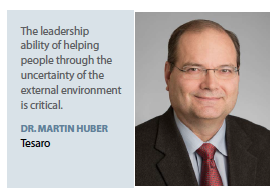 change was necessary," he says. “This is where leadership skills kick in. The first priority of the leadership team is to recognize when chaos is happening. The second is to recognize when we’re potentially the sources of that chaos. Our job is to promote clarity and give clear direction for the organization. We do this by how we structure governance, how we organize teams, and how teams and leadership interact."
change was necessary," he says. “This is where leadership skills kick in. The first priority of the leadership team is to recognize when chaos is happening. The second is to recognize when we’re potentially the sources of that chaos. Our job is to promote clarity and give clear direction for the organization. We do this by how we structure governance, how we organize teams, and how teams and leadership interact."
Dr. Rodman agrees it’s important for leaders to be agile. “When I joined pharma, it was the end of an era," he says. “It was the end of the me-too drugs that were incrementally better. Today, we’re taking full advantage of the genetics revolution, understanding the molecular pathogenesis of disease, and taking drugs from preclinical to market sometimes in as little as four or five years. The world is moving much faster and a leader needs to be much more agile."
Flexibility is critical today, Dr. Rodman says, because timelines are often compressed. “We used to develop drugs in a slow march forward," he says. “Now we have to build trials in a different way and answer multiple questions in early trials."
Additionally, Dr. Gilham says R&D leaders need to be able to synthesize and generate realistic understanding of their company’s particular approach. They need to collaborate with others to take an approach to the next level to ensure that it gets developed and benefits patients.
He says over the last 15 years, R&D has become more collaborative, with more partnerships between academic and clinical researchers.
“There is an ever-broadening and diversifying range of collaborations, which are beneficial to both industry and academia," Dr. Gilham says. “The days of one small technology delivering a major response are gone.
Understanding conditions and developing therapies now require collaborations around basic science, engineering, gene engineering, and cell biology that cross from academia into the commercial area. Delivering results in early phase clinical trials and later-stage clinical trials requires collaboration within an organization and outside of the organization."
Today’s leaders also need to be patient-centric, Dr. Rodman says. “A patient-centric approach is key to success," he says. “It’s easy to get caught up in the business side: is the drug going to make enough money?; Are we going to be better than the competition, etc.? When we do that, we lose track of the real customer. The customer is not the investor. The customer is not the insurance company. When we focus on the final customer, patients, we’ll bring value to them — and to shareholders."
Developing the Next Generation of Leaders
In terms of talent, companies are wrestling with the outsourced model of project management, according to the Deloitte survey. R&D leaders say gaining and maintaining expertise in designing clinical trials is increasingly important, and they aim to become less dependent on CROs in this area.
This will require R&D leaders to focus on developing new talent internally. Our R&D leaders say the next-generation of R&D leaders have to stay curious, passionate, and open to new ideas. It is that drive to actively seek new information and cultivate an environment that embraces full diversity of thought, which will bring forth groundbreaking ideas and meaningful innovation.
A focus on keeping their skills and knowledge current will help this next-generation of R&D leaders effectively build teams and partnerships to take the calculated risks that continue to advance the science and collective understanding.
Dr. Huber says Tesaro, an eight-year-old company, recently experienced a leadership gap, and needed to bring in outside leaders. Since then, the company is working to develop leaders internally. This year, Tesaro began a management-training program. That is then followed by formal leadership development for those individuals the company has identified as possible leaders.
“We’re increasingly focused on talent development," he says. “One of the things we realized that we were missing as an organization was foundational management skills. As we mature as an organization, we are focused on developing our internal talent to not just be effective managers but also leaders.
Ms. Krishnan says it’s important to encourage diversity in leadership roles, by bringing women and minorities to the table.
“I make sure we have an equal opportunity employment workplace, and I want to ensure that people within the organization that have leadership qualities are given the opportunity to demonstrate those skills," she says. “We have a flat organizational structure and I encourage our employees to build relationships internally within the various teams and externally with nonprofit organizations dedicated to rare diseases and with clinical investigators."
She says it’s important for women leaders to encourage other women to pursue leadership opportunities.
“I want to make sure that women in the workforce and on my scientific team can continue to develop and grow and become entrepreneurs like me someday," she says.
At AbbVie, the company invests a lot of time and effort developing its leaders.
“We have several forums at AbbVie to develop leaders," Dr. Scott says. “We have regular meetings where leaders get together and talk about leadership challenges and what’s happening in the industry."
Dr. Scott writes an internal blog where he puts forward his philosophy on leadership.
“One of the first challenges I had when I came to AbbVie was that I had never led an organization of 3,000 people," he says. “I tended to work in smaller organizations where I could touch everybody in the organization through face-to-face communication. In an organization where I don’t get to meet everyone, it’s challenging to promote a leadership philosophy that can survive translation through several layers of management. The blog is a great way to communicate with everybody about the philosophies that I think are critical to our success as an organization."
Dr. Scott is getting ready to launch a new program: Rob on the Run, a lunchtime program where employees can join him on a walk around the AbbVie campus.
“Research shows that when people meet while they’re walking, the quality of information transfer and the learning is higher," he says.
Dr. Lee says Horizon Pharma works closely with several organizations to foster interest in science and technology. “Partnering with the Illinois Science and Technology Institute, we recently hosted local high school students who participated in a competition focused on how to improve delivery of a medicine," she says. “Through our adoption of the Perspectives Math & Science Academy in Chicago, we directly sponsor their robotics team and provide resources for seniors to visit college campuses."(PV)
~~~~~~~~~~~~~~~~~~~~~~~~~
R&D Leaders Navigate Complex Ecosystem
We asked partners of biopharma companies what key skills the next generation of R&D leaders will need to navigate in an increasingly complex ecosystem to make sure that R&D productivity is sustainable.
Mary Mattes
Senior VP, Biometrics & Drug Safety, Synteract
The demands for R&D productivity in today’s pharmaceutical development space continue to increase. The exciting reality is that both the quantity of and accessibility to data and information are also increasing, so there is fertile opportunity to not just sustain but to grow the output of new investigational products. One key skill that R&D leaders will need to take advantage of in this complex ecosystem of data is an understanding of how large datasets are structured and how diverse datasets interconnect, thereby releasing the insights held in their data. Additionally, R&D leaders need to foster an openness to technology innovation with regard to interacting with information, as the advances in computing, data interfacing, and data delivery continue to rapidly evolve. Finally, R&D leaders need to be vigilant in identifying new sources of data, from sources within their own R&D environment to the equally as important sources in related and unrelated fields. The intersection of complex global data stores with pharmaceutical R&D will be the story of product development for the foreseeable future, and R&D leaders with the skills to navigate this arena will become best in class.
Chad Moore
President, Elligo Health Research
Leaders need to focus on patients, and they need to avoid SALY (same as last year) thinking to improve trial efficiency by leveraging new approaches and technologies, and finally, they need to conduct research where patients are — in the community, at their physician’s office.
There are many bottlenecks in the clinical research process including regulatory, technology or lack thereof, and access to patients and physicians. They all contribute to the complexity, length, and cost of conducting studies. However, improvements are being made. We believe that the highest hurdle is access. Let’s make it easy for people interested in participating in research to do so. Only about 3% of people participate in research and those who do must overcome many challenges. These include becoming aware of research opportunities and where studies are conducted; getting comfortable with an unfamiliar research facility, physician, and support team; determining how the information gathered during the study is, or is not, shared with their non-research/real world GP or specialist physician; traveling to/from the research facility; and determining whether time away from family, friends, work is worth participation. It’s time to bring the focus back on patients.
By making it easier for patients to participate in research, recruitment challenges will subside. This can be accomplished by enabling patients to participate in research with their current, known, and trusted physicians acting as investigators. The goal is to take research to the patient vs. the current model of requiring patients to go to where research is conducted. A by-product of this approach is we are creating a new wave of investigators who will mitigate the current shortage.
Regulation follows reality, meaning research should generally be conducted in accordance with how healthcare is delivered and managed.
Improvements are happening but more research teams need to avoid SALY. Just because something was done last year or in the last study doesn’t mean the process should be repeated. R&D leaders need to take a fresh look, ensure regulations are adhered to, and determine if there is a better way — better for the patient, better for the study, better for the investigator, better for the monitor, better for study efficiency.
The availability of tools to ease data collection, reporting, and analysis have all significantly improved research efficiency. In addition, technology developed to identify protocol-matching patients that primarily creates heat-maps identifying general areas of where protocol-matching patients are located has been useful. However, the lack of a way to identify, make outreach, and help those patients interested in participating in a study largely remains elusive.
~~~~~~~~~~~~~~~~~~~~~~~~~
20 Behaviors of High-Quality Leaders
1. Are supportive
2. Champion desired change
3. Clarify objectives, rewards, consequences
4. Communicate prolifically and enthusiastically
5. Develop others
6. Develop and share a collective mission
7. Differentiate among followers
8. Facilitate group collaboration
9. Foster mutual respect
10. Give praise
11. Keep group organized and on task
12. Make quality decisions
13. Motivate and bring out best in others
14. Offer a critical perspective
15. Operate with strong results orientation
16. Recover positively from failures
17. Remain composed and confident in uncertainty
18. Role model organizational values
19. Seek different perspectives
20. Solve problems effectively
Source: McKinsey’s Organizational Health Index
~~~~~~~~~~~~~~~~~~~~~~~~~
Drivers Influencing R&D Priorities
R&D priorities are constantly evolving, driven by rapid shifts in the regulatory and payer environments (particularly in the U.S.), the arrival of new tangible insight on outcomes based on real-world evidence (RWE), and pressures to reduce time to market, according to a 2017 survey of R&D leaders by Deloitte Centre for Health Solutions. This first annual survey aims to examine how R&D leaders are guiding organizations to adapt to changes in the industry.
The most frequently mentioned initiatives were those that were related to developing internal technical and data capabilities, with companies looking to grow their internal capabilities in order to harness growing volumes of data. A major source of cultural challenge is seen at the interface between therapeutic areas and platforms. Companies are attempting to break down silos between functions by forming cross-functional groups and initiatives are under way to promote the importance of sharing knowledge between departments.
In terms of talent, some companies continue to wrestle with the outsourced model where the role of the project manager has changed from managing internal resources to managing a complex budget and vendor model. This points to the importance of talent in the key roles for driving multi-million dollar programs.
Smaller companies are seeking greater access to internal and external talent, using a shift toward a higher level of globalization to achieve this. Further talent initiatives, including hiring new talent in CMC, growing research groups comprising people with broader experience and establishing dedicated translational medicines groups.









